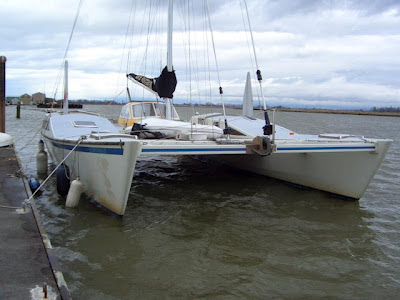“Have I found my granddad’s boat—Dreamtime?”
the email from Ireland
started.
Learning
the history of a boat can be a tricky thing. Being mobile, rename-able, paint-able and in
our case completely renovate-able—it’s easy to lose track of a boat’s history.
Especially once they’ve sailed through a few owners.
 |
| Ceilydh--shortly after buying her |
We knew a
few things about Ceilydh (ex-Dos Cerveza (sigh), ex-Dreamtime). We knew she had
been built in a small yard on Gabriola
Island and launched in
1987. We knew she cruised to Alaska
at some point in her early life. Then we knew the owner died at some point and
the person who bought her tried to charter her as a party boat to indifferent
success. By the time we found her in 2004 she was mossy, mouldy and a refuge
for wasps.
 |
| moss and heaps of 'stuff' showed her neglect |
 |
| but the pretty varnish (old settee area--now main bunk) showed she'd been loved |
As we
brought her back to life we learned things—we met Richard Woods, her designer
and consulted him on our modifications (he suggested the cabin was too boxy—we
agreed, but we’re tall). We met Grey Davis—who worked in the yard where she was
built and learned about the construction methods and materials.
All
excellent stuff.
But if
you’ve ever owned a boat you know they are so much more than systems and
construction techniques. You know that the galleys hold the memories of meals
cooked underway, and celebratory dinners when you hit that special anchorage.
The settees hold the echoes of tall tales and stories told. The wheel holds the
imprint of white-knuckle moments and sublime bliss. The decks hold the stamp of
hard work and quiet contemplation.
"My Granddad’s passion was sailing - more specifically - he loved Catamarans. He knew Richard Woods from his time in the UK - and that's why he chose the Meander design. Before Dreamtime - he owned a 25 foot Cat.I remember being shown home movies of the launch of Dreamtime. The launch was at a place known locally as "The Brickyard" on Gabriola. Roads had to be closed to enable her to drive the short distance from Grey's yard to the launch site.”Her first big voyage was to Glacier Bay, Alaska. My Granddad, Nan, two cousins and myself all set sail for a 3 month trip. (A trip I hope to repeat some day with my wife and 3 kids!!!)I have some wonderful memories of my time with my grandparents on board Dreamtime. I know when you found her she was a little sore on the eyes - but when my Granddad was alive - she always looked great.”
While these memories might somehow be part of the boat, I
think things like the echo of long-ago laughter is usually mistaken for wind in
the rigging. It takes being told the stories for a boat’s past to come back
alive.
“You may notice a little damage on the Starboard Dagger Board - this was caused by an error in navigation - and a 4 hour wait until the tide came in (my Granddad's excuse was that the chart was out-of-date!!!!)Does the fresh water erupt like a volcano when you fill it up? - Apparently this was due to no breathing holes being present in the tanks - it was always a good joke to let someone fill her with water and watch them get a good soaking!”
 |
| Working hard |
Perhaps I’m
a bit of a hopeless romantic, but it makes me feel good that we rescued
Dreamtime and gave her a new life. And I love the images I now have of her
early days—of three cousins and their grandparents on a life changing trip to Alaska…
Curious how
many people know the histories of their boats? Any stories out there?











